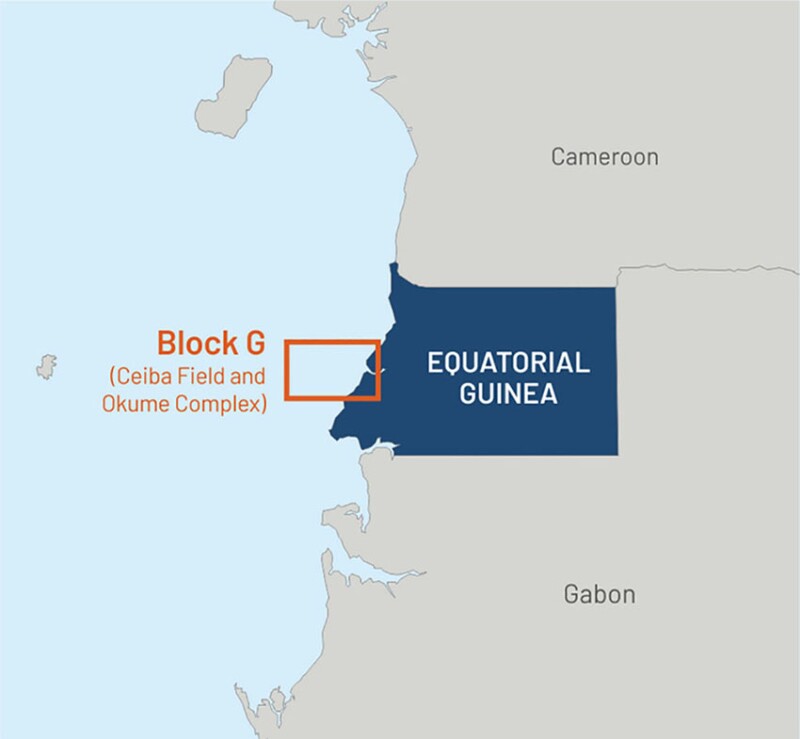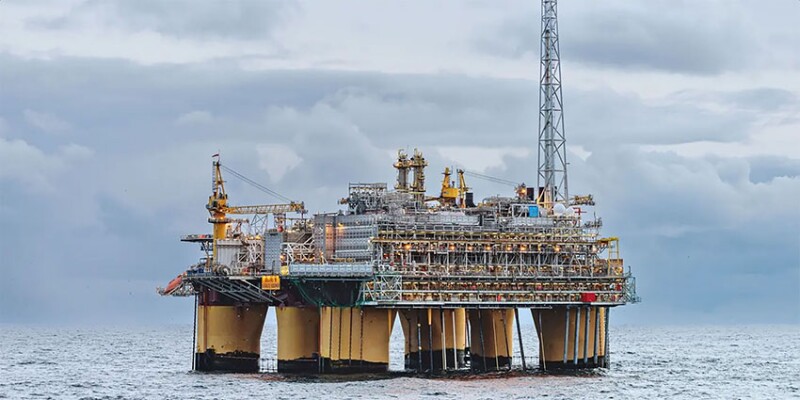Panoro Eyes Progress in Multiple Projects
Panoro Energy announced that the Equatorial Guinea C-45 infill well in Block G, operated by Trident Energy, started production at over 5,000 BOPD on a restricted choke. The well, drilled by the Noble Venturer drillship to a depth of 3148 m, encountered high-quality, oil-saturated reservoir sands in an unswept zone of the Ceiba Field. This is the first of two planned infill wells, with the second, OF-19 at the Okume Complex, set to begin production soon.
Panoro holds a 14.25% stake in Block G, partnered with Trident Energy and Kosmos Energy (each holding 40.375%), and GEPetrol (5.0%).
“With the high-impact Akeng Deep ILX well at Block S due to follow the infill drilling campaign, a successful outcome can also have a positive read across to the adjacent Panoro-operated Block EG‑01 where we are progressing subsurface studies,” said John Hamilton, CEO of Panoro.
The Noble Venturer will drill the Akeng Deep ILX well in Block S, targeting a 180-million-bbl resource in the Albian interval. Panoro also holds a 12% interest in Block S.
The company announced it also signed final agreements for exploration blocks Niosi Marin (previously G12-13) and Guduma Marin (previously H12-13) offshore shallow-water Gabon. Panora holds 25% participating interest in each block.

Crown Point Acquires Santa Cruz Concessions
Crown Point Energy Inc. has completed its acquisition of a 100% operating interest in the Piedra Clavada and Koluel Kaike hydrocarbon concessions in Santa Cruz Province from Pan American Energy. The Santa Cruz Concessions are located on the southern flank of Golfo San Jorge basin, approximately 200 km southwest of Comodoro Rivadavia.
Covering 71,593 acres in the Golfo San Jorge basin, the concessions include infrastructure supporting higher production levels, which averaged 3,223 B/D in the first half of 2024.
The purchase price was $12 million, subject to adjustments, plus contingent in-kind payments over 15 years, with monthly oil deliveries of up to 600 B/D depending on market prices.
Supermajors Return to Libya as Country Launches Bid Round
Libya plans to launch its first energy exploration tender since 2011, seeking to attract oil majors deterred by years of instability. The bid round, set for late 2024 or early 2025, will offer onshore and offshore blocks in the Sirte, Murzuq, and Ghadames basins, according to Oil Minister Khalifa Abdul Sadeq. After resolving a recent political conflict, Libya’s oil production has rebounded to 1.3 million B/D, with a target of 1.6 million B/D by 2025.
“We’re working with Suncor, TotalEnergies, Wintershall, and others to resume their exploration activities in the country,” Saqeq said. The country is also in talks with five international oil companies that have expressed interest in returning to work in Libya.
Aging infrastructure, including corroded pipelines and storage tanks in need of maintenance, are a result of the country’s forced production halts.
Libya plans $17 billion in upgrades to sustain and increase output, aiming for 1.4 million B/D by year’s end, 1.7 million by 2027, and 2 million by 2028.
Sinopec’s Jiyang Shale Oil Project Progressing
Sinopec is progressing its Jiyang shale oil project in Shandong, China, now producing 1600 metric tons per day, up from 100 tons in 2021. This output aligns with Sinopec’s 2022 goal to reach 500,000 tons annually by 2025.
Jiyang, part of the older Shengli oil field and covering 7300 km2, holds an estimated 10.5 billion tons of shale oil, with 1.73 billion tons identified as reserves. The field has 36 active wells, including the highest-producing Fengye 1-1HF well at 262.8 tons per day. Despite significant potential, shale oil extraction remains challenging and costly, contributing only 1% of China’s total crude output.
Chevron Expands African Holdings
Chevron has expanded its exploration acreage in Africa, adding blocks in Nigeria, Angola, and Equatorial Guinea, as it seeks a production revival in underexplored West Africa. Unlike other oil majors, which have reduced or exited their holdings, Chevron has increased its presence, citing untapped hydrocarbon potential.
In Nigeria, Chevron recently acquired a new exploration block and made a discovery petroleum mining lease (PML) 49 in the shallow offshore region of the Western Niger Delta, despite production declining over recent years. The company also gained two deepwater licenses in Equatorial Guinea and signed contracts for ultradeep blocks in Angola, which left OPEC last year after production slumped.
Chevron is also launching exploration in Egypt and Namibia, where other majors like Shell and TotalEnergies have made large offshore discoveries in the Orange Basin, sparking renewed interest in the region.
Long Lake Begins Production in Alberta
CNOOC Ltd.’s Long Lake Northwest Project in Alberta, Canada, has begun production. Operated by CNOOC Petroleum North America ULC, this steam-assisted gravity drainage (SAGD) project includes a new well pad and four pipelines, with eight well pairs planned. It aims to reach peak production of 8,200 B/D by 2025.
Long Lake, located near Fort McMurray, began SAGD operations in 2008 with a capacity of 72,000 BOE/D. In 2018, it expanded with the Long Lake Southwest project, adding 26,000 BOE/D through three additional well pads. A pipeline connects Long Lake to the Cheecham Terminal and the Athabasca Pipeline system.
Shell Finds Proven Gas at Selene Prospect
Shell, along with partners Deltic Energy and Dana Petroleum, has discovered promising dry gas reserves at the Selene prospect in the UK Southern North Sea. The discovery, at the 48/8b-3Z well within the P2437 license area, reached a depth of 3540 m, identifying a 160-m section of Leman Sandstone containing gas. Wireline logging and fluid sampling confirmed a high-quality dry gas column in the B-Sand layer, which is thicker and more porous than anticipated.
Shell plans to demobilize the Valaris 123 jackup rig and will analyze core, fluid, and pressure data to refine geological models and develop an extraction plan. Preliminary estimates suggest Selene contains recoverable resources of about 131 Bcf, with a majority concentrated in the B-Sand, which supports a higher-yield development. The project, expected to proceed without additional appraisal wells, may lead to further exploration in nearby prospects, including Endymion.
Shell serves as operator and holds 50% interest with partners Deltic Energy (25%) and Dana Petroleum (25%).

QatarEnergy Purchases Stake in Egypt
QatarEnergy announced it will purchase a 23% stake from Chevron in an offshore exploration block in Egypt’s Mediterranean waters. Chevron will retain a 40% stake, while Woodside and Egypt’s Tharwa Petroleum hold 27% and 10%, respectively. The North El-Dabaa (H4) block lies about 10 km offshore, with water depths from 100 to 3000 m.
QatarEnergy CEO Saad al-Kaabi emphasized the agreement’s role in bolstering the company’s presence in Egypt and its partnership with Chevron, aligning with QatarEnergy’s strategy to expand its global footprint.
Equinor Increases Ownership in Halten East
Equinor announced it will acquire Sval Energi’s 11.8% stake in the Halten East Unit, increasing its ownership to 69.5%. The project, with an estimated 100 million BOE, is largely gas (60%), which will be exported to Europe via Kårstø. Halten East is a key, low-emission project for Equinor, aligning with its strategy to optimize its Norwegian Shelf portfolio.
Development will occur in two phases, with six wells drilled in phase one (2024–2025) and additional drilling in phase two (2029). Halten East is in the Norwegian Sea and will use Åsgard B’s infrastructure.
Norwegian North Sea Project Receives FID
Vår Energi and Kistos Energy have approved the Balder Phase V project in the Norwegian North Sea, with an investment of $690 million to develop 33 million BOE in proven reserves. This fast-track project will add six new infill wells, utilizing spare slots on the existing subsea infrastructure in the Balder area. Drilling will begin in early 2025, with initial production anticipated by the end of that year.
“With the refurbished Jotun FPSO on track to commence production from the field within Q2 2025 we have the tool to unlock additional production,” said Vår Energi COO Torger Rød.
The Balder area includes the Balder and Ringhorne Øst fields, which have been producing since 1999 and 2003, respectively. Located at a depth of 125 m, these fields feature Jurassic, Paleocene, and Eocene sandstone deposits.
Vår Energi serves as operator and holds 90% interest with Kistos Energy (10%).


